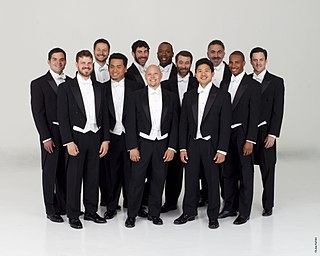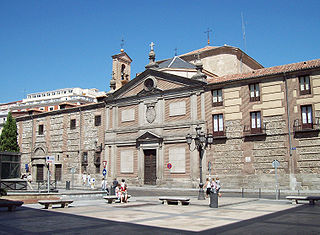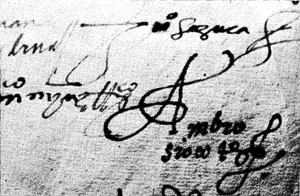A countertenor (also contra tenor) is a type of classical male singing voice whose vocal range is equivalent to that of the female contralto or mezzo-soprano voice types, generally extending from around G3 to D5 or E5, although a sopranist (a specific kind of countertenor) may match the soprano's range of around C4 to C6. Countertenors often are baritones or tenors at core, but on rare occasions use this vocal range in performance.
The musical term alto, meaning "high" in Italian, refers to the second highest part of a contrapuntal musical texture and is also applied to its associated vocal range, especially in choral music. It is also the root word of contralto, the lowest standard female voice type. When designating instruments, "alto" likewise can refer either to the corresponding vocal range or to musical role. The term "alto" is also used to designate a specific kind of musical clef; see alto clef.
Antoine Brumel was a French composer. He was one of the first renowned French members of the Franco-Flemish school of the Renaissance, and, after Josquin des Prez, was one of the most influential composers of his generation.
Mateo Romero was a Belgian-born Spanish composer of Baroque music and master of the royal chapel.

Cristóbal de Morales was a Spanish composer of the Renaissance. He is generally considered to be the most influential Spanish composer before Tomás Luis de Victoria.

Chanticleer is a full-time male classical vocal ensemble based in San Francisco, California. Over the last four decades, it has developed a major reputation for its interpretations of Renaissance music, but it also performs a wide repertoire of jazz, gospel, and other venturesome new music and is widely known as an "Orchestra of Voices". It was named for the "clear singing rooster" in Geoffrey Chaucer's The Canterbury Tales.
Pierre de la Rue was a Franco-Flemish composer and singer of the Renaissance. His name also appears as Piersson or variants of Pierchon and his toponymic, when present, as various forms of de Platea, de Robore, or de Vico. A member of the same generation as Josquin des Prez, and a long associate of the Habsburg-Burgundian musical chapel, he ranks with Agricola, Brumel, Compère, Isaac, Obrecht, and Weerbeke as one of the most famous and influential composers in the Netherlands polyphonic style in the decades around 1500.
Francisco de Peñalosa was a Spanish composer of the middle Renaissance.
Pedro de Escobar, a.k.a. Pedro do Porto, was a Portuguese composer of the Renaissance, mostly active in Spain. He was one of the earliest and most skilled composers of polyphony in the Iberian Peninsula, whose music has survived.
Juan Gutiérrez de Padilla was a Spanish composer in what is modern Mexico.

Officium Defunctorum is a musical setting of the Office of the Dead composed by the Spanish Renaissance composer Tomás Luis de Victoria in 1603. The texts have also been set by other composers including Morales.
Juan Bautista Comes, aka per Valencian spelling Joan Baptista Comes, was a Spanish Baroque composer who was born and died in Valencia.
Theatre of Voices is a vocal ensemble founded by baritone Paul Hillier in 1990; it focuses on early music and new music.
Pro Cantione Antiqua of London (PCA) is a British choral group which was founded in 1968 by tenor James Griffett, counter-tenor Paul Esswood, and conductor and producer Mark Brown. Their first concert was at St Bartholomew's, Smithfield with Brian Brockless conducting but, from an early stage, they were closely associated with conductor and musicologist Bruno Turner. Arguably, they were the leading British performers of a cappella music, especially early music, prior to the founding of the Tallis Scholars.
The Suspicious Cheese Lords, also known as Suscipe Quæso Domine, is an American male a cappella ensemble based in Washington, D.C.. SCL is a wholly autonomous, professional ensemble and a 501(c)(3) not-for-profit organization whose mission is to stimulate interest in early music throughout the metropolitan Washington area and beyond. Secondarily, SCL has established a reputation for researching, recording, and promoting previously unrecorded works of Renaissance composers.
Estêvão de Brito was a Portuguese composer of polyphony.
The Capilla Peñaflorida is a Spanish early music group founded in 1985 by Jon Bagüés.

Ambrosio Cotes was a Spanish Renaissance composer.
Pere Rabassa (Catalan pronunciation: ['peɾə rə'βasə]; was a Catalan composer and musicologist.
Missa L'Homme armé is a part of a mass by Giovanni Pierluigi da Palestrina. It was published in 1570 and consists of four movements.











